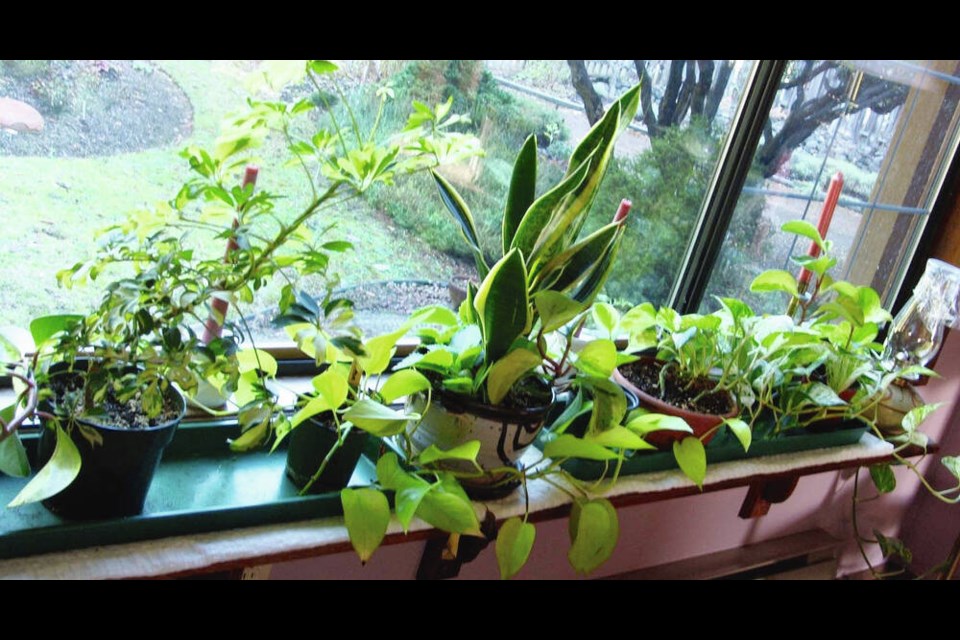Dear Helen: In the spring, I acquired a selection of houseplants to brighten my kitchen and living room. They have been lovely until recently. Now, leaves are dropping. Some have turned yellow. Others have brown tips. A few plants have developed weak, leaning stems. I don’t want to give up on living indoor greenery in winter. What to do?
F.G.
This is a difficult time of year for houseplants as low light levels, short days, and cranked-up heating systems make life difficult for our potted plants.
It’s only in recent years that I’ve re-introduced houseplants to window ledges in my living room and dining room. My son, who has over 100 plants in his tiny studio apartment, brought me some from his collection at Christmas a few years ago.
For a simplified way to keep the plants in decent condition, I acquired 75-cm long windowsill trays. This won’t suit every situation, but it simplified houseplant cultivation for me. I regularly pour small amounts of tepid water into the trays, to supplement watering from the top and to supply needed humidity. There is the added motivation to remember watering: I dare not kill off my son’s plants.
You have described common winter houseplant woes. Here are a few tips on helping to deal with them.
Leaf drop often arises following an abrupt change in temperature or reduction in light. Make any necessary plant moves gradual, and provide the best possible light for plants in winter. Keep houseplants protected from hot or cold drafts from doors and sources of heat. Avoid watering with cold water.
Dry air is associated with leaf drop. Increase humidity by washing or misting the foliage and by setting pots on watertight trays. A group of pots on one tray will receive the benefit of a large evaporating surface.
Overwatering in winter can set plant roots up for rotting, which will cause leaf drop. Reduce watering for most plants in winter, but avoid letting the soil go dry.
Brown leaf tips and edges result from high temperatures, hot drafts, dry air, or/and dry soil. If possible, lower room temperatures slightly, or stick to plants tolerant of warm, dry conditions — dessert cacti, snake plant (Sansevieria) and crown of thorns (Euphorbia milii) for example. Physical contact will damage some plants enough to cause browned leaf tips. Ferns are particularly susceptible to browning from being brushed against.
Yellowing leaves, usually caused by wet soil from watering too often, begins with older, lower leaves discolouring and dropping. The rest of the leaves may wilt. Empty, unrooted soil or plants without well-established root systems make overwatering almost inevitable — a good case for keeping plants in slightly tight pots, and for repotting in spring or early summer when the plants are actively growing rather than in autumn as they head into a rest period.
Reduce water in winter except for plants in active growth. Water only when a good top layer of soil has thoroughly dried and the pot feels lighter than usual when lifted. Then water amply, using room temperature or tepid water.
Weak, leaning growth happens in inadequate light. Leaves grow paler and smaller, and new growth is weak and spindly. Stems elongate and lean as they reach for more light. Distances increase between leaves and the oldest, lower leaves drop. Flowering plants stop blooming, variegated plants lose their distinctive colouring and split-leaf philodendrons stop splitting.
Gradually move affected plants to a brighter location. If no brighter natural light is available, supply some artificial light. In early spring, take cuttings to start younger plants that will grow strong and stocky in the brightening light.
Dear Helen: I cannot understand how aphids come to infest the potted nasturtiums and petunias on my sixth floor balcony every spring and summer.
S.S.
Aphids are most commonly introduced to house and balcony plants on purchased transplants, which are best isolated and monitored for pests before planting them in your pots.
Aphids over-winter as eggs, usually attached to living plants, close to a food source such as a growth bud that will leaf out as the eggs hatch into feeding insects in spring.
Consider doing a thorough cleaning of the balcony and pots early in the spring, monitor purchased plants well and, just to be on the super-safe side, use a planting mix clearly labelled as suitable for indoor use.



